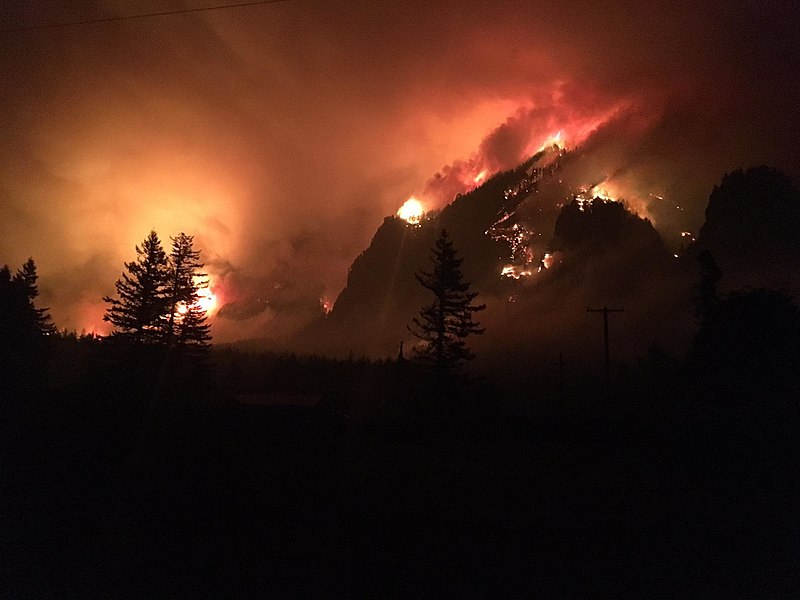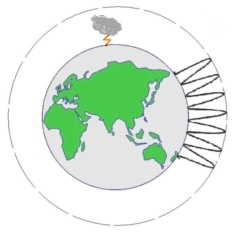In case you aren’t aware, the Columbia River Gorge is on fire. Over the weekend, a group of teenagers setting off fireworks in the Eagle Creek canyon set dry brush ablaze, and as I write this over 20,000 acres are now burning, to include precariously close to well-loved landmarks like Multnomah Falls. Over 150 hikers had to be rescued by the Hood River Search and Rescue Team (who could really use donations, by the way.) The easternmost edges of the Portland metro area are under evacuation warnings, and over forty miles of Interstate 84 are closed in both directions.
What I want to tell you is about how broken I feel at this moment, how powerless and weak. I was thirteen when the woods that were my solace were bulldozed flat to the ground, an event that was legitimately traumatic for me and contributed to both my Generalized Anxiety Disorder and to my deep drive to learn about and protect non-human nature. I want to tell you about how I am suddenly back in that moment of despair, anger and helplessness, and fighting to not fall into the deep pain and disconnection that swallowed me for years afterward. I want to tell you about how the red clay of the earth torn up by machinery a quarter century ago is reflected in the flames in photos of my beloved Gorge, the first place that welcomed me with open arms when I moved to Portland a decade ago, and which is permanently tattooed on my left arm in gratitude. I want to tell you how difficult is it for me to keep to my daily schedule and list of tasks while I know that places where I have set foot for many years are burning to the ground, and all I want to do is curl up in my bed and cry.
Instead, what I am going to tell you is what led to this devastation, and how to respond in ways that actually have a concrete, measurable effect. Perhaps it is my grief and pain that make me more sensitive and cynical, but all the calls to “send energy to the firefighters” and rituals to try to make it rain just seem like wasted effort. Normally I shrug and let people do whatever their path says is right in this situation, but I am raw and angry and fed up as my sacred places burn. We don’t need prayers for rain. We need to stop the processes that are preventing the rain in the first place.
What is happening now is the culmination of centuries of human stupidity and greed. Our climate IS changing because of our industrial activities and the pollutants they create, as well as the destruction of mitigating natural factors like the oceans and forests that are supposed to absorb atmospheric carbon. This is leading to drier, hotter summers in the Northwest; this August was the hottest on record in Portland, and the rest of the area isn’t far behind. The entire area is a tinderbox of dead plants.
Add in many decades of fire suppression led by timber companies not wanting to lose their cash trees, and budget cuts that keep forestry services from engaging in prescribed burns. See, fire is natural in forests; some plants even need fire to properly germinate their seeds. But because fire also damages timber and threatens tourism, any natural lightning-strike fires have been quickly put out, and Smokey Bear reminds us that “only YOU can prevent forest fires.” But this all resulted in the understory of the forest–ferns, rhododendrons, salal, and more–growing much thicker than is natural, and many smaller trees getting a roothold where before fire would have thinned them out. This creates what is called ladder fuel, which allows fire to climb higher into the older trees who, in a normal intensity fire, be protected by their height and thick bark. When fire is allowed to occur naturally, it burns out the understory long before it gets too thick, and the big trees survive, and the seeds in the ground replenish the land. But we humans stopped that, and now all that built up tinder has exploded.
Add in one small group of ill-educated teenagers with illegal fireworks dropping them over a cliff into a pile of brush. Yes, the human brain doesn’t full develop until the mid-twenties, and the part that manages impulse control is still under construction in a fifteen-year-old. And here is where our lack of nature literacy become a problem: if children are raised from a very young age to constantly understand the risks of fire, it become a matter of course to act with respect. There are just certain things you don’t do, because you’ve been brought up with the knowledge of why and what happens when you don’t listen. Yet these entitled little scumsuckers apparently didn’t get the memo, because they were giggling like their act was a big adventure.
So: what to do? Here’s the game plan:
—Educate yourself on the role of fire in forest ecosystems. This goes doubly so if you claim to be a nature-based pagan, or if you somehow think you have an affinity for the element of fire, because you’d damned well better know the actual nature of fire, and not just its mythos and romanticism. Educate yourself on how climate change is leading directly to bigger, hotter, worse fires. And once you’ve educated yourself, educate others, especially anyone who intends to spend any time outdoors.
—Educate your elected officials on all levels about the need for prescribed burns and other forest management practices that will help undo the damage from fire suppression and hopefully mitigate the effects of climate change. Tell them to fund forestry and natural resources services on all levels of government instead of using those funds for really stupid ideas like building a giant wall at the south end of the country. And while you’re at it, make sure you tell them about the connection between climate change and the more devastating fires we’re having, especially if your elected officials are in the minority that happen to still be pretending human-caused climate change isn’t a scientifically-validated reality.
—Urge the stakeholders in the land in the Gorge, both public and private to replant with a wide diversity of trees, not just Douglas firs. Logging companies like the Doug firs because they grow quickly and are valuable on the market, but when you have a landscape that has nothing but the same species, it becomes much more vulnerable to disease and parasites which lead to more dead trees–and more fire fodder. Moreover, they plant the trees more close together than they would be naturally, and as the trees are all the same age there isn’t as much chance for bigger, older trees to shade out smaller ones and thin the herd, as it were. A healthy forest has many trees of different species and ages for a reason, and monocrops of Douglas firs contributed to the fires we now see. Or, better yet, let the forest recover on its own and at its own pace. Here, educate yourself on forest succession and how a forest can come back all on its own.
—Donate money to those who are actively fighting the fires and help people evacuate. I don’t care if all you can give is a single dollar–it HELPS. There will no doubt be local environmental and conservation organizations working to restore the natural and historical features of the Gorge in the aftermath of this, so be on the lookout for their calls for funding.
–And when those organizations call for volunteers, if you’re close enough and can do so, step up. Even a few hours helps. Right now if you want to volunteer call the Hood River Sheriff’s Department at 541-387-7035. And there will be ongoing work. I have spent the past couple of years volunteering for Cascade Pika Watch, and I’m hoping we’ll be able to do a post-fire survey this fall to see how many places still have pikas afterward. The Friends of the Columbia River Gorge and Columbia Riverkeeper are also highly active in this beautiful area’s ecosystem restoration, so no doubt they’ll be involved in whatever work is ahead.
–Work to fight climate change, the biggest factor contributing to greater forest fires, as well as the more violent hurricanes that have been bludgeoning the Southeast. Don’t know where to start with such an admittedly tall order? Here. The Drawdown website lists the 100 biggest causes of climate change and how to fix them. The book goes into even more detail. Pick just one of those causes and put effort toward it, whether it involves making changes in your own life, or pressuring corporations and/or governments to change themselves.That’s how you get started, and you can take that as far as you’re willing. Then pick another cause, and work on it. And so on.
–Most importantly, educate yourself on nature and how it works. We’ve spent centuries trying to distance ourselves from the rest of nature, and it’s been terrible for everyone and everything involved. Maybe if we pagans were as picky about how our paths line up with science as we do with history, we would be a greater force for the planet. Try starting your education with this bioregion quiz from the Ehoah website.
Finally, I know I was pretty harsh on those of you who are praying for rain and trying to send energy to the firefighters and all that. Even if all your rites do is give you some solace in a tough time, that’s constructive enough; just please also focus some on the efforts that are absolutely proven to have a more direct effect on the fires and what caused them. Let your rites inspire you to take more physical action, rather than replacing it. We can’t wave our wands and chant our chants and expect the fire to go out, but we can put our money where our mouth is when it comes to claiming to be practitioners of nature-based spirituality, especially when we need to undo the damage we’ve done to nature more than ever.


















